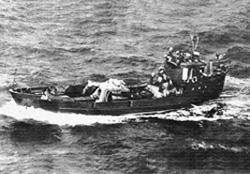
The Disguised Supply Craft on the Open Sea
From the USNavForV Summary of July 1967
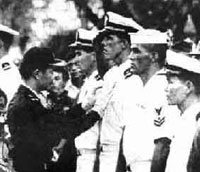
Photograph by Henry Hansen
Pacific Edition of Stars & Stripes
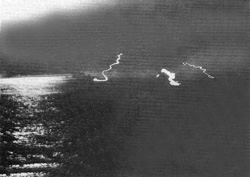
The Supply Trawler Under Fire on July 15
From the USNavForV Summary of July 1967
| Sa Ky River Victory |
| July 15, 1967 |
| Southern River Mouth - Mui Batangan |

The Disguised Supply Craft on the Open Sea |

Photograph by Henry Hansen |

The Supply Trawler Under Fire on July 15 |
Early in the second week of July 1967, PCF-45 was detailed to transport LT Bill Fitzgerald of CosGrp 16 out to the USS Wilhoite DER-397. Bill departed the Song Tra Khuc in a Yabuta, and a rendezvous was established south of Cape Batangan just off the Sa Ky River. From there the Swift proceeded out past Cu Lao Re Island to meet up with the Wilhoite. |
PCF-45 is seen approaching the ship to effect the transfer. While tied up alongside,
some of the crew went aboard for a conversation with the captain. He seemed very
interested in the capabilities of the Swift Boats that operated in-shore from his
barrier position along the twelve mile territorial limit. It was sensed that "something
was up,"but both vessels soon separated to resume their normal patrols. The feelings
of pending events were to be justified during the next few days.
|
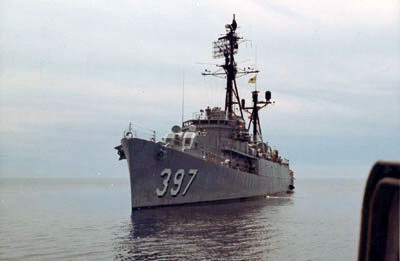 |
Commander Stephan was CTG 115.1, head of Market Time's Northern Surveillance Group, based in Da Nang. He was responsible for leading the efforts to locate and stop any North Vietnamese attempts to infiltrate arms and personnel into the I Corps region from the sea.
Any use of the following text without prior written approval is strictly prohibited.
"At 1925 on 11 July 1967, the pilot of patrol aircraft number 10, Patrol Squadron One, reported to the Market Time Coastal
Surveillance Center in Da Nang that he had contact with a small steel-hulled trawler headed on a course of 220 degrees,
at a speed of 10 knots, and located 55 miles east of Chu Lai. The P2V Neptune aircraft had flown low enough to read the
numerals 459 on the trawler's bow. The pilot further reported that the otherwise unmarked and unidentified vessel had a
large crate on deck and was running without any lights"
"An hour later, the P2V returned to check on the trawler and found that she had turned on her running lights and had changed
course to 120 degrees, a significantly suspicious action. With this move, the USS Wilhoite was ordered to close and
make contact, but to observe covertly. The Wilhoite pursued, made radar contact, and after receiving handoff from
the aircraft, took over the duties of shadowing the trawler."
|
 Chart extracted from the US Naval Forces Vietnam Summary of July 1967 |
"Four months before, on 14 March 1967, another trawler had attempted to infiltrate this same area. This trawler had also been detected initially by Market Time patrol aircraft. In the ensuing hours, surface units of the Market Time force had taken station near this earlier trawler and had forced her ashore. She had beached at about 0600 local time" .. "Suddenly, at 0630, the ship had exploded with such cataclysmic violence that tiny pieces were scattered for a thousand yards in all directions. There was hardly enough of the ship left to be recognizable. Not a single weapon on the March trawler remained usable. There was little question, therefore that the July trawler was similarly rigged and could be expected to destroy herself if not captured before the crew could abandon her." |
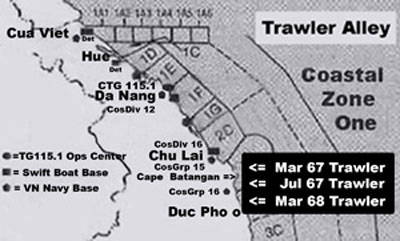 |
"The staff of the Northern Surveillance Group assembled late in the evening of July 13th when they were sure the present trawler
was returning to the Cape Batangan area and began to plan for an operation that would almost surely take place the following night.
The speed of advance of the trawler at that time would have brought her ashore at about 2000 on the 14th, but this was ruled out as
a possibility because the moon would still have been up. And though it was not yet full, it was too bright to risk being seen. It
was therefore reasoned that she would slow up during the late afternoon and try for the beach after moonset, a little after midnight."
"During the afternoon" {of 14 July}, "orders were received from the Task Force Commander to initiate challenge procedures
when the trawler was five miles from the beach. Later he sent a message stating that the trawler had been positively
identified as a North Vietnamese re-supply ship."
|
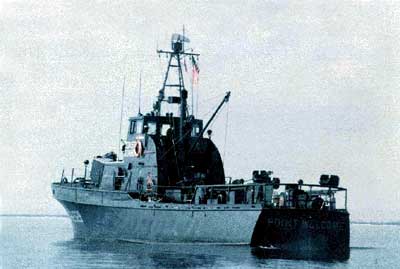 USCGC Point Orient |
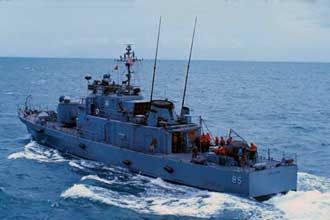 USS Gallup |
Aside note: Commander Stephan designated USCGC Point Orient WPB 82319 and USS Gallup PG-85, both in Da Nang,
to join the Wilhoite and participate in the expected action as the enemy trawler approached the coastline. Commander
Stephan would ride the Gallup down from Da Nang, transfer to the Wilhoite and assume the duties of
Officer-in-Tactical-Command (OTC). Lt. Victor "Pete" Reiling, First Coastal Zone Pyschological Warfare Officer, would be
on board the Point Orient to broadcast taped surrender messages over loud speakers if and when the NVA trawler crossed
into South Vietnamese waters. A Swift Boat was to be added to this trio later. Before leaving Da Nang, station assignments
were manually pre-encrypted for transmission at the appropriate time. Late afternoon on the 14th, the two ships departed Da Nang
to make the rendezvous with Wilhoite: the Point Orient at 1545 and the Gallup at 1700. All three ships
thus converged on Cu Lao Re island, a few miles off Mui Batangan as the evening of July 14th approached.
Commander Stephan's narrative continues:
"The NSG plan called for grouping the ships astern of the trawler in such a way that she could neither turn left or right
to escape, but would have to continue toward the beach."
|
"At 2000, just after dark, the Wilhoite was ordered to take station five miles on the trawler's starboard quarter and the Gallup was ordered to make the long end-around to get to the same position on the port quarter. The Gallup, using her turbine power, reached that position without delay." |
"At this time, the three ships were 22 miles east southeast of Cu Lao Re Island. The loom of the 12-mile light on the island was clearly visible. This powerful beacon is the main navigational aid in I Corps. Both the March and July trawlers undoubtedly had made landfall on it from far out at sea. The Wilhoite's CIC was tracking the trawler, the Gallup and the minesweeper Pledge MSO-492 - which had moved to the southern barrier when the Wilhoite had begun her marathon tracking exercise." | >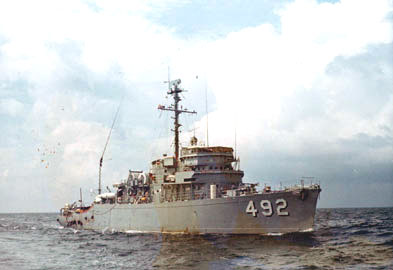 |
"At 2130, a second contact showed south of Cu Lao Re and became dead in the water. A few minutes later the Point Orient reported at rendezvous point, at the location of this second contact." |
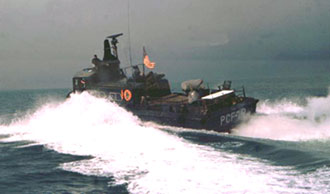 |
"During the hour from 2130 until 2230, the trawler made one or two slight course changes, one of which took her a little further south of Cu Lao Re than had her initial track, but then she steadied down on a westerly course headed directly for the coastline south of Cape Batangan. Shortly thereafter, a message was received from the Task Force Commander advising that a VC "Reception Committee" was waiting just up the Sa Ky river on its northern shore to offload the trawler." |
"This bit of intelligence clinched the trawler's destination. Now it would be possible to select the Swift Boat which
would be closest to the track of the trawler, and therefore the one which was needed to fill the port quarter slot in
the formation. It was the PCF-79
So with all ships selected, at 2230 the encrypted station assignments were sent out, to be executed later on signal."
"The trawler was now 25 miles from the beach. The Point Orient was still sitting up there south of Cu Lao Re, about
nine miles north of track. Since the trawler's best speed was estimated at 15 knots and since the Point Orient's
was only a few more that, it became apparent that the cutter should begin taking station to avoid a long stern chase.
For this reason she was ordered to take station astern of the trawler at 3,000 yards, staying at least three miles from
the trawler until aft of her beam. The Wilhoite and the Gallup were ordered to close to three miles."
"After that, they just steamed, watching the trawler get closer and closer to that 12-mile line" .. {At} "2330, all units
were ordered to preassigned stations. The Wilhoite took station 20 degrees abaft the starboard beam of the trawler
at 5,000 yards, the Gallup a similar station aft the port beam. The Orient and the PCF-79 proceeded
to stations on the starboard and port quarters respectively at 2,500 yards."
"The PCF-79 closed at high speed from the west, circling astern of the Gallup to get to station. She was still
1,000 yards from station, boring in at full speed when the trawler passed the five-mile line from the beach. It was 11
minutes after midnight, 15 July. The quarter moon was low in the west and had gone behind heavy clouds. The Point
Orient was standing by to commence the tape broadcast. On order, the Vietnamese language broadcast began: ...."
|
|
The following narrative is Copyright � 2002 by Ed Bergin and Raul Herrera. All Rights Reserved.
|
|
Ed Bergin, OinC of PCF-79 picks up the story from that point:
Having volunteered for the assignment, PCF 79 was waiting for the approaching vessels in the area known by its designation Two Delta November. This area covered the southern shores of Mui Batangan. If a trawler was coming, my day-to-day patrols along the entrance to the Sa Ky river, on the southern end of the peninsula, had made me absolutely certain that this was where it would head. And now, in the middle of the night, with the sky overcast, the seas running eight to ten feet, and the wind gusting above thirty knots, conditions seemed perfect for an attempted run in toward the calm waters of the Sa Ky. We were "psyched up" and ready for what we were already calling "Skunk Alpha." But by 2300, we were still trying to make sense of the long "shackle coded" message we had received at 2230 from IMPAIR, the radio call sign of CTG 115.1 in his role as OTC. In the best of conditions, Swift Boat communications using only the portable PRC-25 radio was minimal. Taking down a long string of voice transmitted code groups, then looking up each group in a table to break out only one letter or number in the message, in heavy seas, on a 50 foot boat, using only a flashlight, was damn near impossible ... and consequently never completed. But "Bean" (Raul Herrera, SNRM) did get enough of it decoded to indicate the bare essentials. When the execute signal came at 2330, we headed outward from the coast and slipped into the "gaggle" as they neared the island of Bong Than, a short distance southeast of Batangan. We identified the Point Orient and headed toward our assigned position opposite hers. When the Coast Guard Cutter was sent in to play the Psy Ops tape, IMPAIR also told us to illuminate the target. We tried but we didn't see a thing, and none of the other ships reported visual contact either. The rocks and surf around Hon Bong Than had effectively masked the trawler from visual and radar detection. |
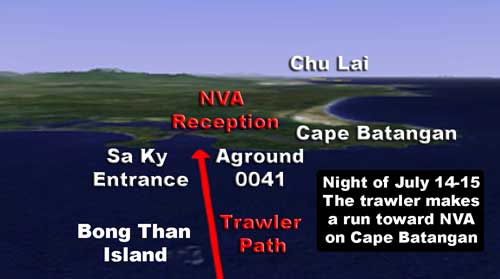 |
But I was still adamant in my conviction that the river was his ultimate destination. I drove as fast as the seas would
allow in that direction. The Point Orient followed in our wake. Sure enough, a big fat radar contact soon appeared
headed straight for the river. As the blip ahead neared the river entrance, IMPAIR asked if I had him, and I replied:
"...he's 700 yards from the river mouth." The immediate reply was "Take him under fire." The Coast Guard confirmed the
contact and I punched the microphone once again to indicate "I'm on my way" and the adrenaline really started pumping.
As Skunk Alpha loomed out of the darkness ahead, we saw the pinpoint flashes of a .51 caliber MG coming from her stern.
I yelled up to Bob Middleton (TM3) in the gun tub to commence firing, and managed to send out a short " ... receiving
fire from target" over the radio. Using the other vessel's luminescent wake as an aiming point, Middleton worked the
tracers up her stern and right into the pilot house. The stern gun was silenced, and I knew we now had a vulnerable point
which could be used to our advantage.
The following sea and our speed carried us up the port side of the trawler. This cleared our fantail weapon and the
M-16 of Nugyen Phant (our VNN liaison) just aft of the cabin area. But our position also cleared the weapons of Skunk Alpha located on the port side
near the pilot house and in the well deck. All hell broke loose from both vessels. Splashes from what could have been
recoilless rifle shells were seen close by.
|
After the first boom from the 81 mm mortar on our fantail, I started hearing loud thumping noises from the direction of the rear end of the boat. All I could think about was those .51 calibers eating up the crew back there. I gave the helm to "Bean", with instructions to maintain course, and ran quickly aft. |
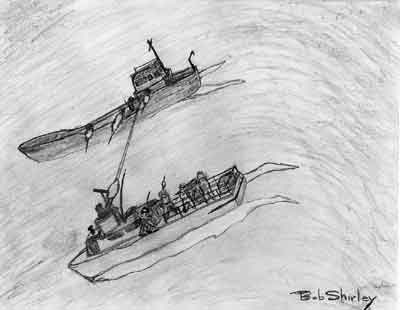 |
"Boats" (Bobby Carver BM1) and "Porky" (Ronald Rineheart EN1) had missed with a low shot from their first mortar round. And in the confusion of being under fire with a gyrating deck underfoot, they were concerned that they had reloaded two rounds on top of one another. In the middle of the turmoil, they had calmly removed their sound powered headsets and were going through the misfire procedures. But Carver wasn't just "gently" tapping the tube as recommended. He was banging it down as hard as he could to get the round or rounds out ASAP so he could get in another shot. |
Convinced they had things well in hand, I rushed back to the pilot house. "Maintaining course" had carried us past
the trawler, and we were heading straight for the shore line. I caught a glimpse of the surf cresting just a few
yards ahead, grabbed the wheel, and put us in a hard left turn. The boat spun on a dime and we were headed back toward
our prey.
Middleton got the topside 50's back on target as we completed the turn and headed back toward Skunk Alpha's port side again,
this time going in the opposite direction.
|
The after 50 joined in as soon as Boats could see her. Phil Heideger (LTJG CosGrp 15 Advisor) even added fire from his old WWII M-1 carbine to the outgoing from the open pilot house hatchway. And Nuygen Phant kept popping away with his M-16. We were spitting out everything we had. As we passed the port quarter of the trawler I made a sharp left turn to bore past that open and vulnerable after end and shield us from the amidships .51 caliber guns that were still blasting away at us. All our weapons converged on Skunk Alpha's pilot house. |
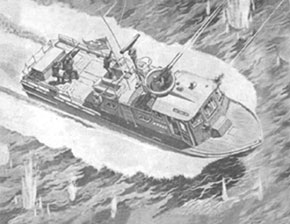 |
I continued the left turn as we reached the starboard quarter, moving in toward Skunk Alpha. But still staying in that
cone of safety behind her stern. When we were about 50 yards off the other vessel, with the starboard side of the fantail
swinging toward that open after end, Boats let go with his second White Phosphorus round. This one didn't miss. It scored a
direct hit on the pilot house, and the trawler lit up like it was the Fourth of July.
|
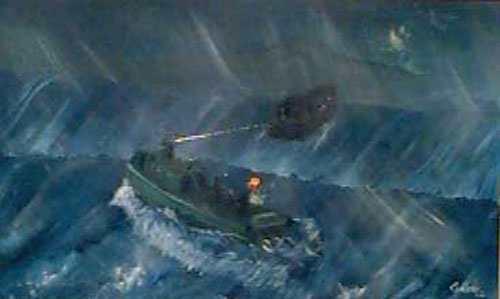 |
As the boat crossed Skunk Alpha's stern for the second time, Carver managed one more shot at her. Then we
just watched in awe as the flaming vessel careened out of control and struck hard near a small islet inside
the calm waters of the Sa Ky. And the realization finally hit us ... we had done it ! There was no more
gunfire from the trawler and she was stuck on the rocks / coral reef looking like a burning pig over a spitfire!!
This reverie was broken by tracers over head from the Point Orient. We were still close in to Skunk Alpha
as the Coasties arrived and they almost fired through us while aiming for the trawler. I jumped on the radio with
a terse request for them to check fire. The sound of their horn coming back through the voice circuit indicated
they were complying with my request. I decided to back off just in case of an ammunition explosion or additional friendly fire.
|
That was a wise move. Both the Wilhoite and the Gallup charged in with three-inch guns blazing. They were soon joined by helicopter gun ships from the Americal Division, dropping flares and hosing down the trawler with machine gun fire. The ROK Marines even entered the fray with a 155 mm artillery bombardment. A destroyer came up from her support position south of Quang Ngai and also took in a few licks. {editors note: The USS Walker (DD-517)} |  |
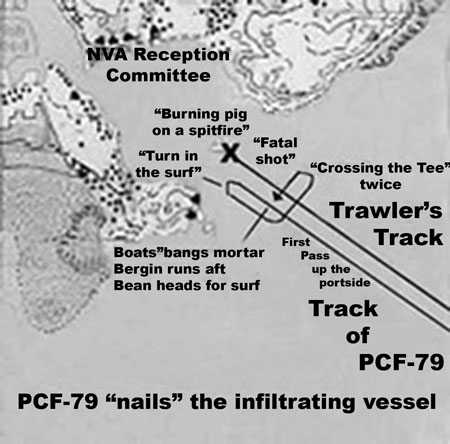 |
All this was just beating a dead horse. Hunting dogs nipping at the kill. Being so close to the trawler when Carver's
WP round caused the after pilot house to disintegrate and the enemy vessel to erupt into a funeral pyre, there wasn't any
doubt in my mind that no one was left alive as Skunk Alpha became adrift on the rocks. And with the amount of ordinance
falling around the small islet where the carcass was hard aground, the possibility that the Viet Cong could have reached it,
much less off loaded anything, was essentially zero.
After a couple of hours being an observer to the show, I asked that we be relieved. And after receiving permission, headed back to
Chu Lai.
|
Enroute, we placed a broom sticking up from the gun tub - the traditional US Navy symbol for a clean sweep.
Upon arrival at the Swift pier in Chu Lai, I opened up a bottle of scotch and our crew and anyone else we could round up had
one hell of a celebration as the sun just peeked over the eastern rim of the South China Sea.
|
The story continues with the Aftermath the next day: The salvage of the trawler, a look at its contents, and the activities surrounding and associated with what the Vietnamese came to call: "The Great Sa Ky River Victory" |
|
On March 24, 2003 ... the day after the Swift Boat Reunion ... the five foot by three foot original
artwork "Crossing the Tee" was delivered to the United States Naval Academy for permanent display on
the academy grounds. It is hoped and felt that this accurate depiction of the stopping of the North
Vietnamese infiltrating resupply vessel in turbulent seas on a dark, eventful night will be an
inspiration to future naval leaders attending this prestigious institution.
The artwork is seen being accepted by Dr. J. Scott Harmon, Director of the USNA Musuem (and USNA
graduate) from Bob Shirley {on right}. After suitable framing in the well equipped museum shops, the artwork
will be hung in one of the academy's many historic buildings. Most likely this will be in the building
housing the department of history .... which will be entirely appropriate.
|
 |
This web site is Copyright � 2002 by Robert B. Shirley. All rights reserved. Click on image to return to the homepage
|